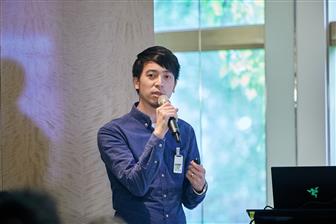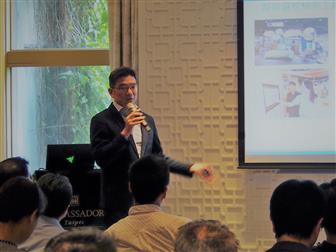The retail industry is among the most valuable businesses in the world but the rise of e-commerce in recent years has delivered a blow to physical retail. Smart transformation of traditional retail has become a definite trend. According to Deloitte's 2019 Global Powers of Retailing and Retail Industry Outlook reports, 2019 is a year of transition for the global retail industry. Retailers need to leverage technology to grab preemptive opportunities and boost competitive edge.
To facilitate a smooth transformation for Taiwan-based system integrators and retailers, world-leading electronic shelf label (ESL) solution provider SES-imagotag hosted the 2019 omni-channel smart retail forum, where SES-imagotag executives from its French headquarters joined professionals from leading high-tech and retail firms around the world to share views on smart retail trends and market solutions.
Smart retail holds massive growth potential
Charming Su, APAC Director, Business Project & Solution, SES-imagotag, pointed out during the opening speech that the shelf edge has become indispensable for smart retail. Shelf edge solutions with smart functions will play an instrumental role influencing last-minute consumer decisions in front of store shelves. SES-imagotag is not only a 26-year veteran in this field but also the world's top publicly listed companies specializing in smart shelf solutions.
According to Su, the concept of smart retail has been around for many years. SES-imagotag's short-term strategy for the global market will be to first target the world's top 250 iconic retailers and for regional markets to focus on the top 30 local retailers. Startup retail brands with development potentials that are just beginning to take off will also be a highlight of SES-imagotag's efforts toward the Asia Pacific region.
Aside from shedding light on the company's strategies, Su also made some suggestions as to how retailers can incorporate shelf edge. Taking ESL for example, Su noted for ESL to be effective, the right information has to be displayed in the right place at the right time, to the right clients. This is the new hyper-local approach to digital marketing that is commonly adopted in recent years, wherein popular digital media in specific regions, such as WeChat in China and Line in Taiwan, are incorporated in marketing campaigns to give a local touch and blend into the local lifestyle.
Hyper-local marketing builds on four levels. The first is the legacy approach, wherein there is no standardized pricing strategy, marketing decisions are not made with consideration on market factors and are not executed with synchronized sales activities. For example, a product sold online may have a different price tag when it is sold in a brick-and-mortar store. Such a practice is optimized at the second level, wherein pricing strategies take market demand into account but still do not react quickly enough to changes. For example, prices of umbrellas are not timely adjusted when it starts raining. At the third level, pricing and marketing strategies are dynamic and can more swiftly react to changes to closely match market demand. At the top level, prices can change automatically to respond to current situations in real time, thereby maximizing profits. For example, ESL can automatically adjust the selling price when the expiration date approaches to increase the chance of making a sale.
To help retailers achieve the highest level of hyper-local marketing, SES-imagotag introduced VUSION Cloud, combining advanced ESL technologies, ultra-low power consumption IoT communication infrastructure, high-resolution video, and sensors to enable POS, shelves, digital signage to intelligently, simultaneously and dynamically adjust prices and thereby increase store revenue.
Like a Swiss Army knife, VUSION Cloud provides a complete set of tools for the retail industry
Guillaume Portier, SEVP Business Development, Marketing APAC, SES-imagotag, traveling all the way from the company's headquarters in France, analyzed the IoT trend for the retail industry and indicated since the introduction of ESL a decade ago, a myriad of smart shelf solutions and new technologies have emerged and put to use. They kick-started a smart revolution for the retail industry. It is SES-imagotag's mission to leverage these new technologies and help retailers connect the range of devices in their stores and improve operation efficiency while making more services available to consumers. VUSION Cloud is representative of SES-imagotag's work in this endeavor.
VUSION Cloud is a smart IoT platform built on ESL technologies. By combining peripheral devices and equipment, it can digitize all information in a store, precisely position every product in the warehouse or on the sales floor, and provide store managers real-time shelf information. When orders need to be placed, VUSION Cloud can offer ordering suggestions based on recent sales records. Employees are also reminded to restock shelves when items run out. According to Portier, like a Swiss Army knife, VUSION Cloud provides a wide and comprehensive range of services for retailers to choose from and build a system perfectly fitted to their needs.
Portier further noted the retail industry runs a delicate operation. A detail could pivot a shopper's decision. To make retail services more refined, the quality of store information that is available is critical. High-precision information not only can help improve a manager's operation performance but with smart implementations, it can also allow the system to make autonomous and automatic responses. This also enables store employees to concentrate on work only humans are capable of, for example, warm and thoughtful services, and thereby maximize their value.
Commenting on the changes the retail industry have undergone in recent years, Portier pointed to the impact that e-commerce has imposed on physical retail. Under such difficult circumstances, for retailers to enhance their competitiveness, they need to strengthen their relationship with customers and in doing so, boost their service quality, to which customer information will be the key.
Information on shopper behavior will be instrumental to physical retailers making smart transformation. According to Portier, the next-generation retailers have to use a wide range of IT devices to collect shopper information, including where they go after entering the store, where they stop and what items they look at. Such information should also encompass whether store staff provided any assistance when the shopper was browsing the merchandise and whether the shopper finally purchased what he was looking for. In the IoT era, all such information can be collected through IT systems. However, the quality of the information and how it is being put to use will be the key to the survival of retailers engaging in cut-throat competition in today's business environment.
Microsoft builds a new-generation retail information platform
Jacob Hsiao, Senior Cloud Product Manager, Marketing & Operations Division, Microsoft Taiwan, gave an in-depth look into the application of big data analytics, IoT and cloud technologies in the retail sector. Digital transformation has become strategically important to the operations of wide-ranging industries over recent years. The retail industry representing a large share of the global economic value will particularly need digital transformation.
With e-commerce and omni-channel marketing becoming a prevailing trend, which has completely changed the global retail business model, traditional department stores and big retail chains sustain a blow. However, according to Hsiao, the change did not begin today. He drew on Toys "R" Us for example. Its strategy was to simply sell all kinds of toys but it soon drove small toy stores out of business, making itself the leader in the market segment. However, Toys "R" Us closed all its US stores in 2018. Its rise and fall exemplified the changes the retail industry has undergone. The new wave of smart retail not only will incorporate more innovative and cutting-edge technologies but will also make retailers start to think differently.
Hsiao was of the opinion that information, encompassing information on shopper behavior and retail worker experience will be key to the new retail business model. Microsoft offers a solution for the retail industry by providing an easy-to-use smart platform for business owners and consumers that combines the two types of information with high-performance computation and analysis.
E Ink pioneers e-paper technology development
Electronic paper (e-paper) displays have been instrumental to the smart retail revolution and e-paper technologies have been making leaping advances over recent years. E Ink, a leading innovator of e-paper technologies, produces 65% of the e-paper displays used in ESL worldwide. According to Jim Chang, AVP, Product Management Central Div., E Ink, e-paper brought about a revolution to the way people read. Since the launch of its e-reader in 2004, E Ink has been driving the advances of e-paper products and technologies.
With the retail industry trending toward more digital driven intelligence, E Ink's e-paper products are increasingly used in retail applications. Chang indicated today's retail industry has never-before-seen needs. To cope with fierce market competition, prices of goods in stores are being updated faster and faster. This not only adds to store employees' workload but also introduces a higher possibility of errors such as missed or wrong price updates. ESL will be the ideal solution to address such problems. Network-capable ESL allows prices to be updated at the upper-level systems and can be installed anywhere. Their simple design also enables them to maintain reliable operation over long periods of time.
In addition to ensuring ESL can maintain long-term operation through ultra-low power consumption and long battery life designs, E Ink's product also features a wide-operating temperature range to guarantee normal display under -25°C - 40°C, a wide viewing angle to create a free viewing experience, and color display to enable better usability for ESL on the shelf. With the retail industry rapidly moving toward digital intelligence, ESL holds promising potential. E Ink has years of experience in this field and has developed products and technologies that set itself apart from the competition, said Chang.
Aruba helps businesses craft the new experience economy
Shelf edge devices including ESL should be convenient to use and operate precisely and reliably. The network communication module is fundamental. According to Magic Hsu, Sales Director and General Manager, Aruba Taiwan & Asia Emerging Countries, experience is the most critical thinking in designing retail systems. Consideration on experience should include not only shopper experience but it is also important to take into account store employee experience.
Retail systems at brick-and-mortar stores are used by shoppers in addition to sales, logistics, warehouse, IT, procurement and other retail professionals. Experiences of all these users across different links of the retail operation must be taken into consideration when designing a smart logistics system. Aruba provides a solution in response to such needs.
With a comprehensive product portfolio targeting the network communication sector, Aruba's architecture can be used in a complete range of network-capable retail systems including POS, inventory data collectors, and even automated guided vehicles (AGV). Hsu commented that Aruba provides high-performance transmission, stable and secure network communication quality and diverse applications enabled through integrations of partner resources. For example, by making use of indoor positioning technologies, Aruba can help shoppers pinpoint where the products being promoted on flyers are on the sales floor, which can further bring about a myriad of uses and values.
Testrite Group precisely analyzes shopper behavior with smart implementations
In addition to equipment providers giving an in-depth look into technological trends and product features, Taiwan's leading home improvement retailer Testrite Group also presented how the company makes use of smart IT systems to raise store operation efficiency and optimize shopper experience at the forum.
According to Chunnan Chen, Vice President of Enterprise Data Technology & Customer Analysis, Testrite Group, the company began to introduce different systems to analyze shopper behavior at its TLW and HOLA stores around Taiwan a few years ago. First of all, it uses the Wi-Fi Listening platform to record the number of shoppers by day, month and year. The gathered data is then sent to the back-end "dashboard" for managers to analyze and evaluate the efficacy of marketing campaigns against the campaign budget. Aside from Wi-Fi Listening, AI cameras are also installed at TLW and HOLA stores to track shopper movement and analyze shopper flow. Store managers can then have a clear picture as to where the hot and cold spots are inside their stores and thereby arrange the merchandise accordingly to maximize shop floor efficiency.
As an enhancement to shopper experience, HOLA makes use of a "smart pillow selection" system, which integrates big data analytics, AI and expert systems. According to Chen, compared to other products, consumers seldom buy bedding items such as pillows and mattresses without trying them out first. This is an area where brick-and-mortar stores have an advantage over online shopping sites and where HOLA excels as well. Aiming to optimize shopper experience, HOLA came up with the smart pillow selection system by performing AI model training on its sales records of pillows while incorporating doctors' expert opinions. People who shop for pillows at HOLA stores can enter their physiological data and the system will provide three recommendations for pillows that suit their needs.
Strengthening smartphone uses and enriching shopper experience
Current market trends clearly indicate new technologies, both software and hardware, have reshaped the retail business. Jean-Christophe Solus, Global Innovation Director, SES-imagotag, highlighted the importance of smartphones to the new retail world in his presentation.
Solus noted smartphones enable a richer range of products as well as faster and more convenient payment methods. They have completely changed people's buying behavior. From a macro perspective, such a trend will continue to develop. In view of this, SES-imagotag's next move will be to leverage close integration with smartphones and create even more engaging experience for consumers shopping in brick-and-mortar stores.
Solus specifically talked about a new concept of smart retail - Pure Players Can't Do That (PPCDT). Through well-planned digitization designs, services that employees in physical stores may have difficulty providing are made possible. For example, ESL can serve as micro webpages to deliver a wealth of product information or can work in connection with smartphones to help shoppers find the products they want faster. Moreover, SES-imagotag is promoting a more convenient anonymous mobile payment system that is ready-to-use without having to download apps or register in advance. This can expedite the shopping process and ease store employees' workload.
The PPCDT concept extends beyond smartphones to other devices. For example, by enabling smart shelves to display advertisements, retailers can boost sales and more than that, they can charge brand vendors for running ads on their smart shelves. Brand vendors, on the other hand, can effectively target their ads for specific products at specific audience, thereby getting the most out of their advertising budget.
Digital intelligence enables differentiating shopping experience and enhances competitiveness of brick-and-mortar stores
At the forum, all the speakers highlighted how important it is for the retail industry to embrace digital intelligence. By building up IT systems and applications, not only can retailers boost the operation efficiency of brick-and-mortar stores but they will enable differentiating shopping experience. The digital intelligence trend is not a thing of the future. It is happening now. Meeting the retail revolution head on, system integrators and retailers have to pick up pace in order to maintain a leading edge amid the intense competition.

Charming Su, APAC Director, Business Project & Solution, SES-imagotag

Guillaume Portier, SEVP Business Development, Marketing APAC, SES-imagotag

Jacob Hsiao, Senior Cloud Product Manager, Marketing & Operations Division, Microsoft Taiwan

Jim Chang, AVP, Product Management Central Div., E Ink

Magic Hsu, Sales Director and General Manager, Aruba Taiwan & Asia Emerging Countries

Chunnan Chen, Vice President of Enterprise Data Technology & Customer Analysis, Testrite Group

Jean-Christophe Solus, Global Innovation Director, SES-imagotag
DIGITIMES' editorial team was not involved in the creation or production of this content. Companies looking to contribute commercial news or press releases are welcome to contact us.

